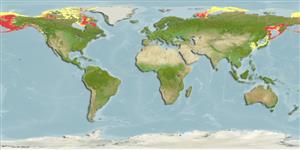Actinopterygii (ray-finned fishes) >
Pleuronectiformes (Flatfishes) >
Pleuronectidae (Righteye flounders) > Pleuronectinae
Etymology: Hippoglossoides: Greek, ippos = horse + Greek, glossa = tongue + Suffix oides = similar to (Ref. 45335). More on author: Gill.
Environment / Climate / Range
Ecology
Marine; demersal; oceanodromous (Ref. 51243); depth range 0 - 425 m (Ref. 50550), usually ? - 150 m (Ref. 6793). Temperate, preferred ?
North Pacific: Hokkaido, Japan and the Sea of Okhotsk north to northeast of Cape Lisburne, south to northwest of Akutan Island, Aleutian chain, Alaska. Arctic Canada.
Size / Weight / Age
Maturity: Lm ? range ? - ? cm
Max length : 30.0 cm SL male/unsexed; (Ref. 559)
Short description
Morphology | Morphometrics
Dorsal
spines
(total): 0;
Dorsal
soft rays
(total): 67-80;
Anal
spines: 0;
Anal
soft rays: 51 - 62. Mouth large; teeth on each jaw uniserial; anterior teeth on each jaw somewhat enlarged, not canine-like; upper eye completely lateral; upper surfaces of eyeballs not scaled; interorbital space narrow, not ridged, and covered with several scale rows; caudal fin slightly rounded (Ref. 559).
Life cycle and mating behavior
Maturity | Reproduction | Spawning | Eggs | Fecundity | Larvae
Cooper, J.A. and F. Chapleau, 1998. Monophyly and intrarelationships of the family Pleuronectidae (Pleuronectiformes), with a revised classification. Fish. Bull. 96(4):686-726. (Ref. 30193)
IUCN Red List Status (Ref. 115185)
CITES (Ref. 94142)
Not Evaluated
Threat to humans
Harmless
Human uses
More information
Common namesSynonymsMetabolismPredatorsEcotoxicologyReproductionMaturitySpawningFecundityEggsEgg development
ReferencesAquacultureAquaculture profileStrainsGeneticsAllele frequenciesHeritabilityDiseasesProcessingMass conversion
Tools
Special reports
Download XML
Internet sources
